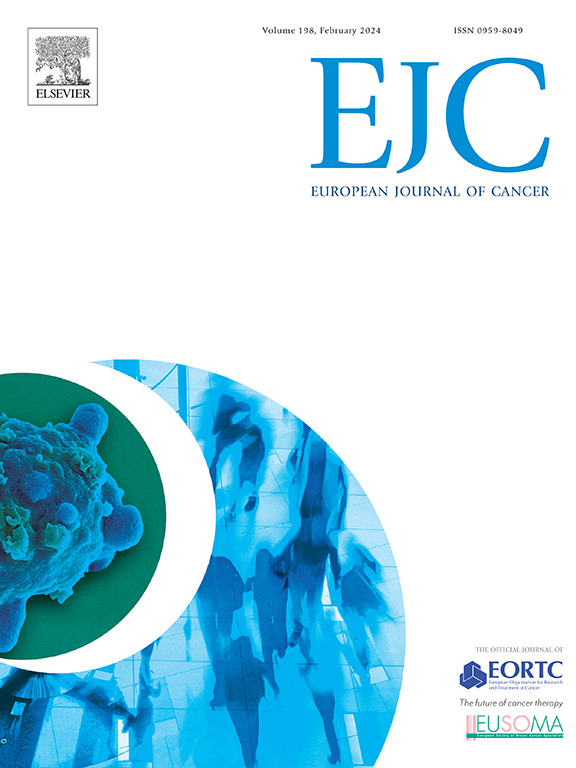The relative dose intensity of first-line FOLFOXIRI and FOLFOX/FOLFIRI both in combination with bevacizumab affects prognosis of metastatic colorectal cancer patients: A pooled analysis of TRIBE and TRIBE2 studies
IF 7.6
1区 医学
Q1 ONCOLOGY
引用次数: 0
Abstract
Background
The relative dose intensity (RDI) of cytotoxic agents affects cancer patients’ clinical outcome, especially in the curative setting. Poor data are available in metastatic colorectal cancer (mCRC) and with specific regard to the use of the triplet FOLFOXIRI.
Methods
We performed a pooled analysis of the phase III TRIBE and TRIBE2 studies comparing FOLFOXIRI/bev to doublets (FOLFOX or FOLFIRI)/bev in order to assess the prognostic impact of the RDI (<80 % versus ≥80 %) during the first 8 cycles of induction treatment of both the triplet and the doublet regimens.
Results
Overall, 282/581 (49 %) and 404/580 (70 %) of patients treated with FOLFOXIRI/bev and doublets/bev, respectively, received RDI≥ 80 %. Patients receiving RDI≥ 80 % had more favorable clinical condition and tumor-related prognostic features. RDI≥ 80 % was associated with higher ORR (62 % vs 53 %, OR: 1.44, 95 %CI:1.13 – 1.82; p = 0.0026), and longer PFS (11.5 versus 10.0 months; HR: 0.80, 95 %CI: 0.71 – 0.91; p < 0.001) and OS (27.9 versus 22.2 months; HR: 0.75, 95 %CI: 0.65 – 0.85; p < 0.001). These results were confirmed in multivariable models (p < 0.001). Similar ORR (58 % vs 56 %, OR: 1.09, 95 %CI: 0.81–1.48; p = 0.57), PFS (10.8 versus 10.0 months; HR:0.96, 95 %CI: 0.83–1.12; p = 0.63) and OS (22.9 versus 24.9 months; HR:1.07, 95 %CI: 0.90–1.26; p = 0.46) were observed between patients treated with FOLFOXIRI/bev receiving RDI< 80 % and those treated with doublets/bev receiving RDI≥ 80 %. These results were confirmed after stratification for unbalanced baseline characteristics between these subgroups (stratified pORR=0.55; pPFS=0.70; stratified pOS=0.33). As expected, patients in the RDI< 80 % group experienced a higher incidence of severe chemo-related adverse events (72 % vs 34 %, p < 0.001).
Conclusions
Maintaining an adequate RDI in the first-line therapy of mCRC improves patients’ clinical outcomes. Since there is no benefit from chemotherapy intensification in the case of low RDI, the secondary prophylaxis of chemotherapy-related severe adverse events might be preferrable rather than individual agents’ dose reductions.
一线FOLFOXIRI和FOLFOX/FOLFIRI联合贝伐单抗影响转移性结直肠癌患者预后的相对剂量强度:TRIBE和TRIBE2研究的汇总分析
细胞毒性药物的相对剂量强度(RDI)影响癌症患者的临床预后,特别是在治疗环境中。在转移性结直肠癌(mCRC)中,关于FOLFOXIRI三联体使用的具体数据很少。方法我们对III期TRIBE和TRIBE2期研究进行了汇总分析,将FOLFOXIRI/bev与双胎(FOLFOX或FOLFIRI)/bev进行比较,以评估在三联体和双联体方案诱导治疗的前8个周期中RDI (< 80% % vs≥80 %)对预后的影响。结果FOLFOXIRI/bev组和doublets/bev组患者RDI≥ 80 %,分别为282/581(49 %)和404/580(70 %)。RDI≥ 80 %的患者有更有利的临床状况和肿瘤相关预后特征。RDI≥ 80 %与较高的ORR相关(62 % vs 53 %,OR: 1.44, 95 %CI:1.13 - 1.82;p = 0.0026),更长的PFS(11.5个月vs 10.0个月;Hr: 0.80, 95 % ci: 0.71 - 0.91;p <; 0.001)和OS (27.9 vs 22.2个月;Hr: 0.75, 95 % ci: 0.65 - 0.85;p & lt; 0.001)。这些结果在多变量模型中得到证实(p <; 0.001)。相似的ORR(58 % vs 56 %,OR: 1.09, 95 %CI: 0.81-1.48;p = 0.57),PFS (10.8 vs 10.0个月;Hr:0.96, 95 % ci: 0.83-1.12;p = 0.63)和OS(22.9个月vs 24.9个月;Hr:1.07, 95 % ci: 0.90-1.26;p = 0.46),接受FOLFOXIRI/bev治疗的患者RDI为 80 %,接受doublets/bev治疗的患者RDI为 80 %。这些结果在对这些亚组之间不平衡的基线特征进行分层后得到证实(分层pORR=0.55;ppf = 0.70;分层pOS = 0.33)。正如预期的那样,RDI<; 80 %组的患者经历了更高的严重化疗相关不良事件发生率(72 % vs 34 %,p <; 0.001)。结论在mCRC一线治疗中保持适当的RDI可改善患者的临床预后。由于在低RDI的情况下,化疗强化没有益处,因此化疗相关严重不良事件的二级预防可能比单个药物的剂量减少更可取。
本文章由计算机程序翻译,如有差异,请以英文原文为准。
求助全文
约1分钟内获得全文
求助全文
来源期刊

European Journal of Cancer
医学-肿瘤学
CiteScore
11.50
自引率
4.80%
发文量
953
审稿时长
23 days
期刊介绍:
The European Journal of Cancer (EJC) serves as a comprehensive platform integrating preclinical, digital, translational, and clinical research across the spectrum of cancer. From epidemiology, carcinogenesis, and biology to groundbreaking innovations in cancer treatment and patient care, the journal covers a wide array of topics. We publish original research, reviews, previews, editorial comments, and correspondence, fostering dialogue and advancement in the fight against cancer. Join us in our mission to drive progress and improve outcomes in cancer research and patient care.
 求助内容:
求助内容: 应助结果提醒方式:
应助结果提醒方式:


